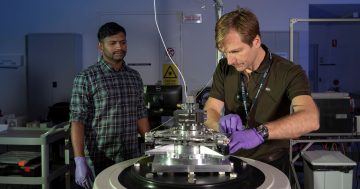
The upgraded optical ground station will support future NASA crewed missions to the Moon and to Mars. Photo: ANU.
An upgraded optical ground station will be established at the Australian National University’s Mount Stromlo Observatory in the ACT to support future NASA crewed missions to the Moon under the Artemis program, and onwards to Mars.
The ANU Quantum Optical Ground Station is a telescope that will support high-speed advanced communications with satellites from low-Earth orbit to the Moon and other deep space laser communication. It will also support future research on advanced communications technologies, providing satellite networks with quantum security and global connectivity.
With support from the Australian Space Agency’s (ASA) ‘Moon to Mars’ initiative, the station is being upgraded with the latest optical technology that will enable communication between the station and future NASA-crewed missions beyond low-Earth orbit.
The station received major funding from the ACT Government’s Priority Investment Program with additional support from the Australian Space Agency, CSIRO and TESAT.
ACT Chief Minister Andrew Barr labelled the ground station as a key national asset that positions Australia and the Indo-Pacific region to collaborate and compete on the global stage.
“Canberra has the capabilities to support space industry success and to take advantage of the enormous investment being made globally in space, through our growing knowledge economy,” Mr Barr said.
“The ANU Quantum Optical Ground Station is another of the ACT’s strategic space sector co-investments that will enable competitive advantage for Australia’s space industry, attract talent from researchers, academics and industry to the ACT not only to help our economy continue to diversify but to equip industry with vital infrastructure to innovate and grow.
“The ACT Government is proud to have supported this ambitious project through our Priority Investment Program.”
Associate Professor from the ANU’s College of Science Francis Bennet said the ground station was the preeminent technology of its kind in Australia.
“Using lasers, the ground station will allow us to communicate with satellites and crews hurtling through space, supporting major crewed space missions and future space exploration,” he said.
“We have built systems that are cutting edge in their capability, and upgrading them to be compatible with NASA missions that will help permanent operations on the Moon, and improve astronauts’ ability to connect back with Earth and allow high-definition video from the Moon and Mars.”
Director of the ANU Institute for Space Professor Anna Moore said the optical ground station was a stellar example of how ANU and Australian research was making major contributions to the future of space technology and exploration.
“It’s really exciting to see this new technology that will play a pivotal role in major future space missions come online,” Professor Moore said.
“With this technology, we will also be able to better access unused data and information about the universe.
“We are thrilled that this station is now built and excited about the pivotal role it will play in our exploration and understanding of space. We look forward to working with our project partners on this nation-leading technology for many years to come.”





